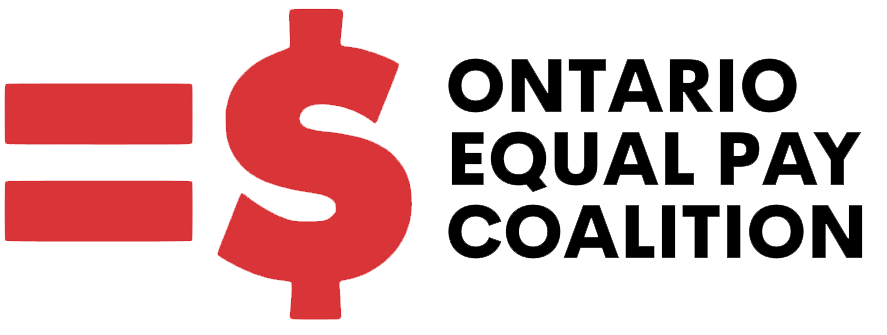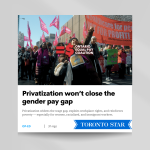November 19th Update! Read our latest fact sheet on Bill 149.
Pay transparency helps close the gender pay gap and eliminate other pay discrimination by making employers prove they are complying with existing laws to deliver discrimination-free pay.
The Ford government has recently announced that it will be introducing legislation affecting workers’ rights. Included in that law will be a pay transparency provision that requires employers to include pay range information in public job postings.
While this is important, it is not anywhere close to a full pay transparency law. In fact, the commitment the government has proposed is a significant retreat from the full Pay Transparency Act that the Coalition fought for and won in 2018. That legislation was scheduled to take effect, but in November 2018 the Ford government amended the law so it would only come into effect on an undefined date proclaimed by the government. So while the law was never repealed, it has also never been proclaimed in effect.
Ontario’s statements to date indicate its proposed law would be one of the weakest pay transparency laws in Canada. And its proposal significantly undercuts the rights enacted in Ontario’s Pay Transparency Act, 2018.
That pay transparency law was never repealed, but the government blocked it from coming into force after the 2018 provincial election.
We’ve created a checklist of effective pay transparency measures to hold employers accountable.
| What to look for in Pay Transparency legislation | Y/N? |
|---|---|
| 1. Is there a CLEAR PURPOSE STATEMENT linking pay transparency to the elimination of discrimination in pay? | |
| 2. Does the law apply to both private-sector AND public-sector employers? | |
| 3. Does the law apply to ALL employers with 10+ workers to ensure it is consistent with the Ontario Pay Equity Act? | |
| 4. Does the law apply to require pay transparency for ALL jobs at ALL income levels in the workplace? | |
| 5. Does the law require an ANNUAL REPORT to the Ministry of Labour detailing wage structure, gender pay gaps, gender distribution across income levels, and gender distribution by job security? | |
| 6. Does the law require that employers’ annual pay transparency reports be PUBLICLY POSTED AND ACCESSIBLE on a government website? | |
| 7. Does the law require that employers provide the annual pay transparency report to ALL WORKERS at the same time that it is filed with the Ministry of Labour? | |
| 8. Does the law PROHIBIT employers from asking job applicants about their compensation history? | |
| 9. Does the law require employers to track and report pay gaps in hourly wages, median earnings and annual earnings by GENDER, RACE, DISABILITY and other key human rights grounds? | |
| 10. Does the law require employers to track and report pay gaps in TOTAL COMPENSATION, including incentive payments, allowances, profit-sharing, bonuses, etc.? | |
| 11. Does the law require employers to track and report pay gaps by ACTUAL JOB CLASSIFICATIONS, particularly jobs dominated by women? | |
| 12. Does the law require employers to track and report gender and other human rights pay gaps BASED ON JOB STATUS (full-time, part-time, casual, seasonal or hired through temporary help agencies)? | |
| 13. Does the law require that the ACTUAL PAY for all jobs (annual salary and pay per hour equivalent) be PUBLICLY AVAILABLE to current and prospective employees? | |
| 14. Does the law PROTECT workers’ right to ask for and receive from the employer information about the wage structure and pay policies? | |
| 15. Does the law PROTECT workers’ right to share pay information with other workers? | |
| 16. Does the law PROHIBIT employers from disciplining or imposing reprisals on workers for seeking and sharing wage information? | |
| 17. Does the law EMPOWER Ministry of Labour inspectors to require employers to disclose records relating to pay and review pay structures for gender inequality and other human rights inequalities? | |
| 18. Does the law give workers the RIGHT TO FILE COMPLAINTS to enforce their right to receive annual pay transparency reports if employers fail to file the mandatory pay transparency reports with the Ministry of Labour or provide them to workers? | |
| 19. Does the law impose significant financial PENALTIES on employers who fail to comply with the pay transparency law? |





